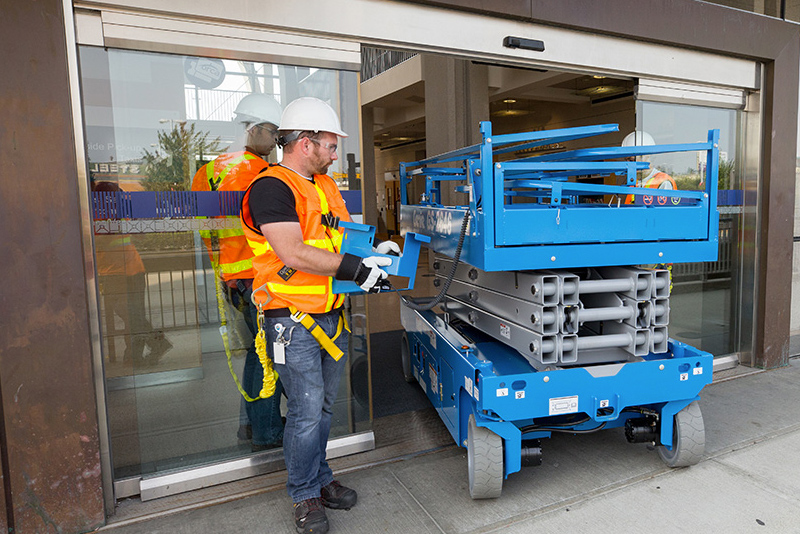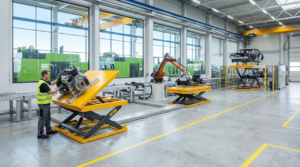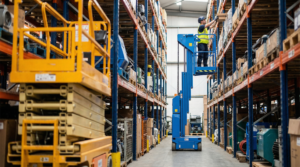What are Electric Powered Scissor Lifts?
Electric powered scissor lifts are essential pieces of equipment in modern industries, providing a stable and reliable platform for lifting personnel and materials to height. Unlike their diesel-powered counterparts, these lifts operate using electric motors and batteries, making them particularly suited for indoor applications. They are widely utilized across various sectors, including warehousing, construction, manufacturing, logistics, and distribution.
Electric vs. Diesel Powered Scissor Lifts – Which is Better?
When choosing between electric and diesel-powered scissor lifts, it’s crucial to understand the specific needs of your operation. Diesel-powered lifts are known for their robust performance and suitability for outdoor environments, especially rough terrains. However, they have downsides, such as noise, emissions, and higher operational costs. On the other hand, electric scissor lifts bring different advantages and challenges to the table, which we will explore in detail below.
Learn More: SCISSOR LIFT SAFETY FEATURES AND CERTIFICATIONS
Electric Powered Scissor Lifts: Pros and Cons
Pros
Quieter Operations
One of the most significant advantages of electric scissor lifts is their quiet operation. Unlike diesel lifts, which can be quite noisy, electric lifts run smoothly and silently. This makes them ideal for indoor environments where noise reduction is essential, such as warehouses, retail spaces, and manufacturing plants. A quieter workspace contributes to a more pleasant and productive environment for employees.
Zero Emissions
Electric powered scissor lifts produce zero emissions, making them environmentally friendly and compliant with stringent indoor air quality regulations. This feature is particularly important in enclosed spaces, where diesel emissions could pose health risks to workers. Additionally, the absence of emissions aligns with corporate sustainability goals and reduces the overall carbon footprint of operations.
Lower Operational Costs
While the initial purchase price of an electric scissor lift may be higher than that of a diesel unit, the long-term operational costs are significantly lower. Electric lifts require less maintenance since they have fewer moving parts and no engine oil or filter changes. Furthermore, electricity is generally cheaper than diesel fuel, leading to lower energy costs over time. These savings can add up, making electric scissor lifts a cost-effective choice for many businesses.
Ease of Use
Electric scissor lifts are known for their ease of use. They offer smooth and precise controls, allowing operators to maneuver them with minimal effort. This user-friendliness reduces the learning curve for new operators and enhances overall productivity. Many electric models also come with advanced safety features, such as automatic braking systems and overload protection, further ensuring the safety of personnel.
Cons
Runtime is Limited
One of the main drawbacks of electric scissor lifts is their limited runtime. These lifts rely on battery power, which means they need to be recharged periodically. Depending on the battery capacity and the intensity of use, the runtime can vary. In high-demand environments, this limitation can lead to downtime as the lift recharges. Companies may need to invest in additional batteries or charging stations to mitigate this issue.
Outdoor Usage is Restricted
While electric scissor lifts excel indoors, their performance in outdoor settings is often restricted. They are typically not designed for rough terrains or adverse weather conditions. Additionally, their batteries can drain faster in cold temperatures, further limiting their outdoor usability. If your operations require frequent outdoor work, especially on uneven ground, a diesel-powered lift might be more suitable.
Higher Initial Expenses
As mentioned earlier, the upfront cost of electric scissor lifts is generally higher than that of diesel models. This higher price tag can be a deterrent for some businesses, especially those with tight budgets. However, it’s essential to consider the long-term savings in operational costs and maintenance when evaluating this initial investment. The total cost of ownership for electric lifts may be lower over time, despite the higher purchase price.
Limited Range
Another limitation of electric scissor lifts is their range. Since they rely on battery power, their operational range is confined to the battery’s capacity. This can be a hindrance in large facilities where long travel distances are required. To overcome this issue, businesses may need to strategically place charging stations throughout the facility or use lifts with swappable battery systems.
Learn More: SCISSOR LIFT SAFETY: WORKING AT HEIGHTS WITH CONFIDENCE
Conclusion
Electric powered scissor lifts offer numerous advantages, such as quieter operations, zero emissions, lower operational costs, and ease of use. These benefits make them an excellent choice for indoor applications and businesses prioritizing sustainability and cost-efficiency.
However, it’s essential to weigh these advantages against the limitations, including limited runtime, restricted outdoor usage, higher initial expenses, and limited range. By carefully considering your specific operational needs and long-term goals, you can make an informed decision about whether electric scissor lifts are the right fit for your business.





